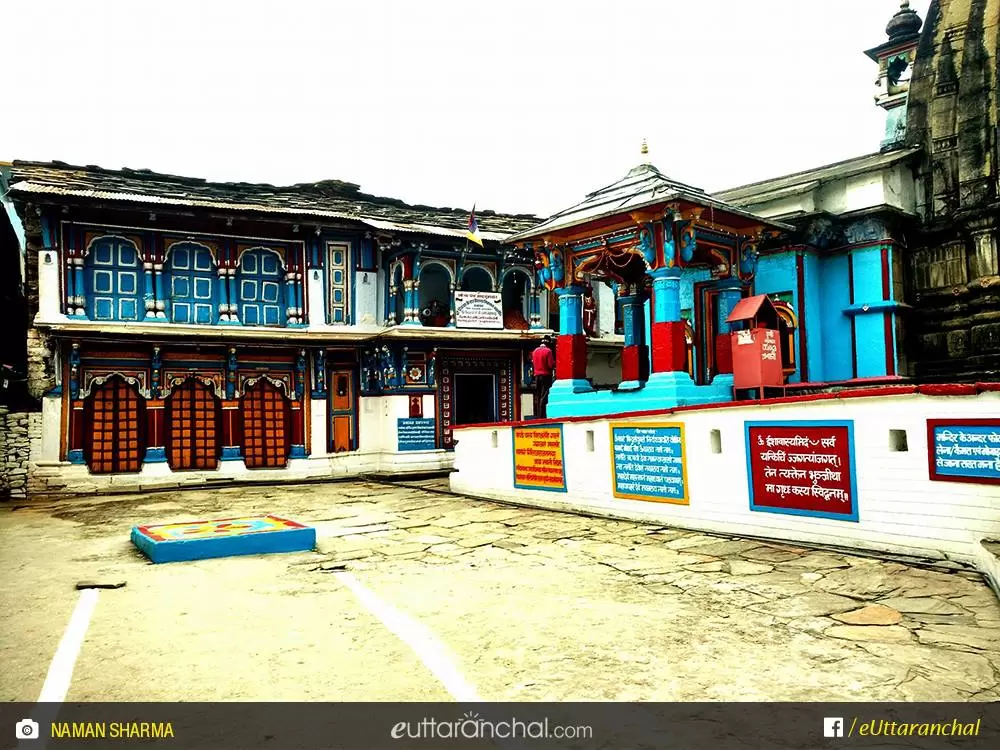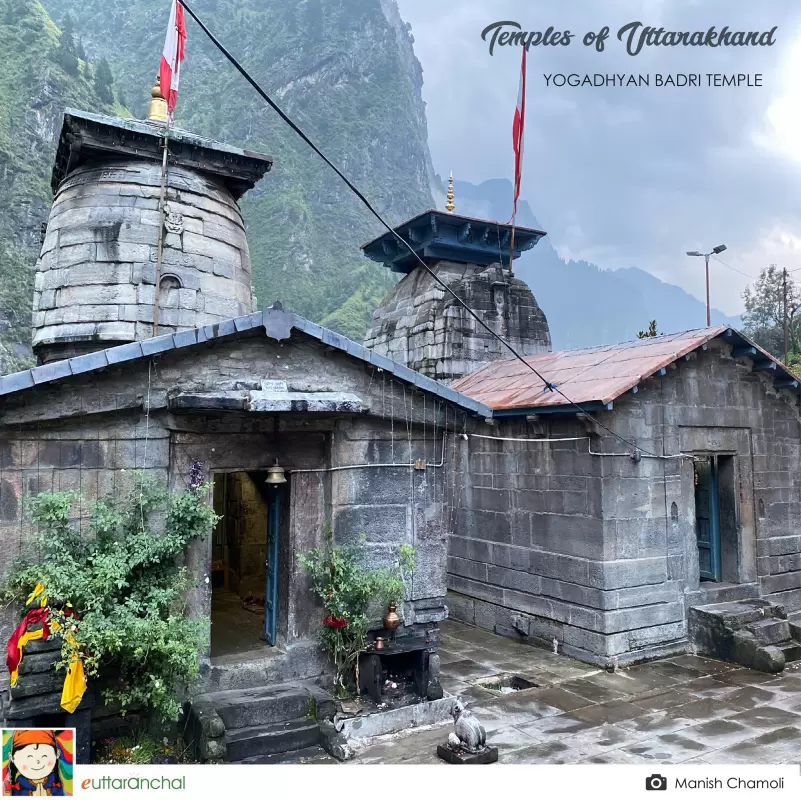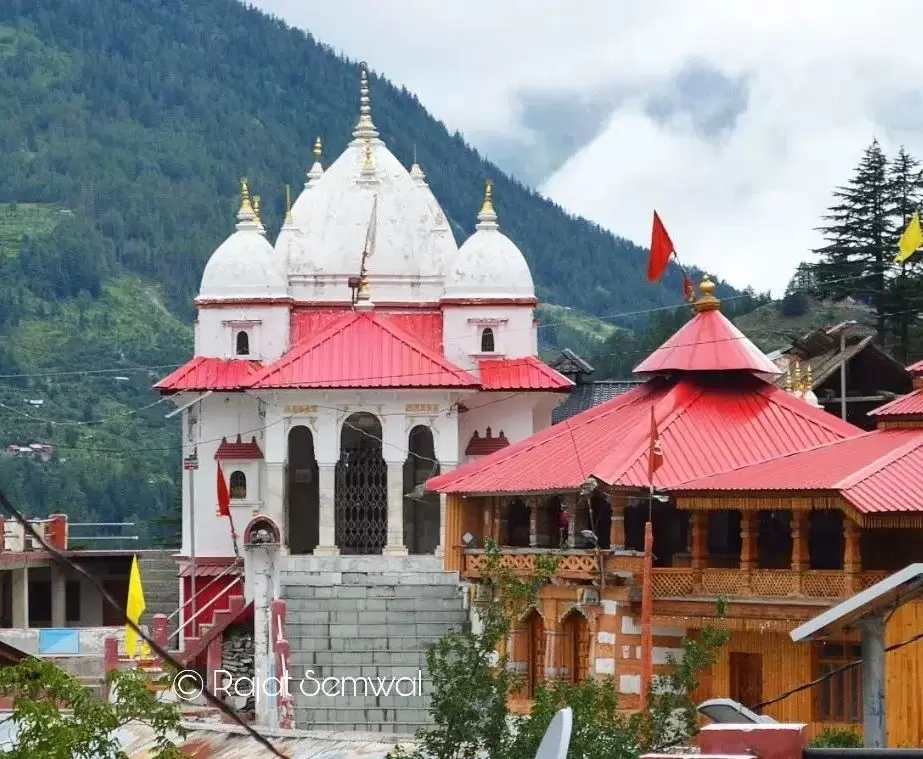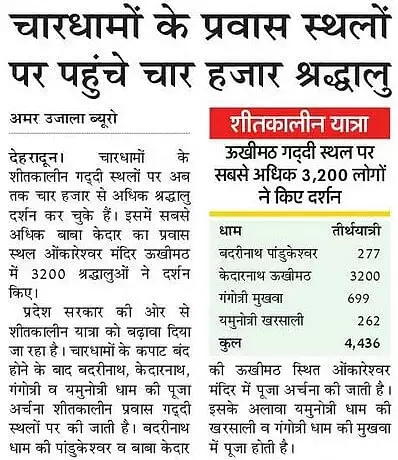The Uttarakhand tourism department has decided to continue the CharDham Yatra in the hills at the time of winters as well. As the Char Dhams sites are covered under the snow during winter, all the Char Dham deities are worshiped at their nearby wintery sojourns namely Ukhimath, Joshimath (Pandukeshwar), Mukhba and Kharsali for the deities of Kedarnath, Badrinath, Gangotri and Yamunotri respectively.
Here is the List of Winter abodes of Char Dham Temples in Uttarakhand. Pilgrims can take Darshan, perform Puja/ Path/ Aarti at winter abodes in Winter Abodes of Char Dham Temples.
Traditionally the pilgrimage starts in May and Ends in October/November with the onset of winters. As the Shrines receive heavy snowfall during winters and are inaccessible, the Idols and symbols are moved to nearby Temples which remain open during winters.

All the Char Dham deities are worshiped at their nearby wintery sojourns namely Ukhimath, Pandukeshwar, Mukhba and Kharsali for the deities of Kedarnath, Badrinath, Gangotri and Yamunotri respectively. The gates to all these winter Dhams will remain open for devotees making the Char Dham Yatra a year long affair.

Omkareshwar Temple in Ukhimath

Narsingh Temple in Joshimath

Ganga Temple in Mukhwa

Yamuna Temple in Kharsali
A visit to the sacred Char Dham washes away all sins and opens doors for ‘Moksha’ or liberation. Every Hindu should consider visiting these four holy places at least once in their lifetime.
To make this sacred pilgrimage hassle free, several tour operators have tailored winter Char Dham Yatra packages that offers pilgrimage as well as accommodation and transportation facilities to the devotees.
Day 1: DELHI – HARIDWAR
Morning, drive to Haridwar (230 kms – 6 to 7 hrs journey). On arrival at Haridwar, check in to your Hotel. In the evening, visit Har ki Pauri to witness the revered Ganga Aarti on the banks of the Ganges. Overnight stay at Haridwar.
Day 2: HARIDWAR – BARKOT
In the morning depart for Barkot which is located at the foothills of Yamunotri (205 kms – 6 to 7 hrs). You will be taken via Mussoorie so visit Kempt Falls on the way. On arrival at Barkot, check-in to your hotel/ camp, pre-booked for you. The day is free to relax and acclimatization. Store your energy for the next day climb to Yamunotri. Overnight stay at Barkot.
Day 3: BARKOT – KHARSALI – BARKOT
Today morning after breakfast, depart for Kharsali (40 kms). Yamunotri (3,291 m) is the western most shrine of the Char Dham. It is the source of the river Yamuna, the sister of Yama, the God of Death. It is believed that anyone who bathes in her waters get relief from a tortuous death. The original source of the river is in Champasar Glacier which is 1 km ahead of the shrine (4,321 m). After your visit to the temple, take a holy dip in the river and perform other religious rites here. Come back through the same route to Barkot, for overnight stay in hotel.
Day 4: BARKOT – UTTARKASHI
This morning, drive (85 kms – 3 hrs journey) towards Uttarkashi. On arrival check in to the hotel. The rest of the day is free for acclimatization. In the evening, visit the famous Vishwanath Temple. Overnight stay at a hotel in Uttarkashi.
Day 5: UTTARKASHI – MUKHBA – UTTARKASHI
Today you need to drive to Mukhba early morning. Perform the Puja at the Gangotri Temple. Late afternoon drive back to Uttarkashi. Dinner and overnight stay at Uttarkashi.
Day 6: UTTARKASHI – RUDRAPRAYAG
Wake up early morning and finish your breakfast to check out from the hotel. Today you will be driving for Rudraprayag via Tehri Dam. On arrival at Rudraprayag, check in to the hotel. It is a small town on the confluence of river Alaknanda and Mandakini. Here in Rudraprayag you can see two separate routes for Kedarnath and Badrinath. Overnight stay at Rudraprayag
Day 7: RUDRAPRAYAG – UKHIMATH – RUDRAPRAYAG
This morning drive to Ukhimath, the winter abode of Lord Kedarnath. Perform the religious rites and later also visit Chopta. But if you are travelling in December, you will not be able to climb Chopta, as it gets covered with thick layers of snow. Later drive back to Rudraprayag for overnight stay.
Day 8: RUDRAPRAYAG – JOSHIMATH
Early morning, after breakfast, check out of the hotel. You will be taken through some of the most wonderful ghat roads. On arrival at Joshimath, check into the hotel. Take some rest and refreshments. Visit to Yogadhyan Badri temple in Pandukeshwar in the evening. Overnight stay at Joshimath.
Day 9: JOSHIMATH – RUDRAPRAYAG - RISHIKESH
This morning after breakfast, visit Omakareshwar Temple in Joshimath. Late check out of the hotel. You will drive downhill to Rishikesh. Rishikesh is the Yoga Capital of India and a spiritually enriched city. On arrival at Rishikesh you’ll be transferred to your hotel for overnight stay. In the evening, visit Parmarth Niketan to take part in the Ganga aarti on the banks of the Ganga. After your visit to Paramarth Niketan you are free to explore this holy town on your own. Overnight stay in Rishikesh.
Day 10: RISHIKESH – HARIDWAR – DELHI
This is the last day of your Chardham Yatra. So wake up at leisure as per the check out time and have your breakfast. You will be taken back to Delhi (260 kms – 7 to 8 hrs). En-route you will get a halt of a couple of hours at Haridwar to take a holy bath at Har ki Pauri on the Ganges. Drive back to Delhi.
Winter Char Dham Yatra is only started recently and yet has managed to attract pilgrims to these shrines. Some pilgrims prefer Do Dham Yatra which consists of deities from Badrinath and Kedarnath. Char Dham Yatra from Delhi is also a feasible option in winter season.
The Char Dham Yatra is a revered pilgrimage in Hinduism, comprising four sacred destinations Yamunotri, Gangotri, Kedarnath, and Badrinath. These sites are located in the Himalayas and are believed to be the abodes of key deities: Yamuna, Ganga, Kedarnath, and Vishnu (in his form as Badrinath).
For centuries, millions of devotees have begin on this journey seeking spiritual fulfillment, purification of the soul, and liberation from sins.
The Char Dham Yatra holds immense significance, as it is believed that completing the pilgrimage grants divine blessings and helps one attain Moksha (liberation). Visiting these holy sites allows devotees to connect with the divine, offering prayers and performing rituals at each temple.
The journey is considered both a spiritual quest and a personal transformation, with many pilgrims undertaking the Yatra as a lifelong ambition
During the winter months, the Char Dham pilgrimage Yamunotri, Gangotri, Kedarnath, and Badrinath becomes difficult to undertake due to heavy snowfall and extreme weather conditions that make access to the temples nearly impossible.
As a result, the idols of the deities are shifted to their respective winter seats to ensure devotees can continue worshipping. These winter seats are special locations where the idols are enshrined for the off-season, offering a unique spiritual experience.
For instance, the idol of Goddess Yamuna is relocated to Kharsali, Goddess Ganga is moved to Mukhba Village, Lord Kedarnath's idol is placed at Ukhimath, and Lord Badrinath's idol is moved to Pandukeshwar. These winter abodes are located in serene and easily accessible places, ensuring devotees can still visit and perform rituals during the winter months.
The Winter Char Dham Yatra is different from the regular Char Dham pilgrimage in that it allows pilgrims to experience the sacred journey during the off-season. The usual crowds thin out, and the atmosphere is calm, offering a more intimate connection with the divine.
Additionally, the beauty of the winter landscapes, covered in snow, adds a unique charm to the pilgrimage, making it an extraordinary spiritual journey. This seasonal relocation also helps preserve the sanctity and safety of the main Char Dham shrines, ensuring their continued reverence throughout the year.
The Winter Char Dham Yatra offers a unique spiritual experience by allowing pilgrims to visit the winter abodes of the Char Dham deities during the off-season. With fewer crowds and shorter queues, the journey becomes more peaceful and personal.
The snow-capped mountains, frozen waterfalls, and serene winter landscapes create a tranquil atmosphere, enhancing the spiritual experience. For those who were unable to visit the Char Dham shrines during the summer season, the winter seats of the deities provide an ideal alternative, allowing them to seek blessings and perform rituals in a calm and less crowded setting.
The deities of the Char Dham temples are shifted to their winter abodes during the harsh winter months to ensure that pilgrims can continue their prayers, pujas, and darshans despite the challenging weather conditions.
The main Char Dham destinations Yamunotri, Gangotri, Kedarnath, and Badrinath experience heavy snowfall and extreme cold from late November to March, making it difficult for devotees to access the temples and perform rituals.
To maintain the sanctity of the pilgrimage and allow continued worship, the idols of the deities are shifted to nearby locations, known as their winter seats, where the devotees can visit, offer prayers, and seek blessings. These winter homes provide a safe and accessible place for worship until the temples reopen for the summer season.
1. Yamunotri to Kharsali
Kharsali serves as the winter abode of Goddess Yamuna, located about 10 km from the main Yamunotri Temple. Due to the heavy snowfall and harsh weather conditions during the winter months, the deity's idol is moved to Kharsali, ensuring that devotees can continue their worship despite the inaccessible conditions at the main temple.
The Yamunotri Temple in Kharsali plays a vital role in maintaining the spiritual continuity of the pilgrimage, offering a serene and peaceful atmosphere for prayers, rituals, and darshan during the off-season. Visiting Yamunotri in Kharsali during this time provides a unique and tranquil experience, away from the usual crowds, allowing pilgrims to connect deeply with the divine amidst the serene winter landscape.
2. Gangotri to Mukhba Village
During the winter months, Mukhba Village serves as the winter residence of Goddess Ganga, located about 27 km from the main Gangotri Temple. The Mukhba Temple is a serene and peaceful location where pilgrims can visit for darshan and participate in local rituals, which include offerings, prayers, and the traditional aarti.
The temple remains open for worship throughout the winter season, allowing devotees to pay homage to the goddess and receive blessings. Mukhba Village also holds great cultural significance, as it is home to unique local traditions and customs that are upheld during the winter months. The village offers a glimpse into the rich cultural heritage of the region, with its rituals and celebrations tied to the worship of Goddess Ganga.
3. Kedarnath to Ukhimath
The idol of Lord Shiva is ceremoniously carried on a palanquin from the Kedarnath Temple to the Omkareshwar Temple in Ukhimath. The Rawals, priests of Kedarnath, accompany the idol and perform rituals at the Omkareshwar Temple in Ukhimath.
Ukhimath serves as the winter home for Lord Kedarnath, offering stunning views of the Kedarnath and Neelkanth peaks. It’s a peaceful retreat for travelers seeking tranquility away from crowded hill stations.
The idol shifted to Ukhimath is a sacred process, with the same rituals carried out as in Kedarnath. The Omkareshwar Temple in Ukhimath is significant, as it’s closely connected to Lord Kedarnath and provides a divine sanctuary during winter. During the winter, devotees visit Ukhimath for darshan and prayers, continuing their spiritual connection with Lord Kedarnath, while the temple remains open for worship.
4. Badrinath to Pandukeshwar
When the Badrinath Temple closes for winter, Lord Badrinath’s idol is moved to the Yogadhyan Badri Temple in Pandukeshwar, which serves as his winter residence. The Yogadhyan Badri Temple, over 1200 years old, becomes a key pilgrimage site for devotees during this period.
Pandukeshwar is a peaceful town in Uttarakhand, where Lord Badrinath stays during the winter months, continuing to bless his devotees.
During winter, the Yogadhyan Badri Temple hosts rituals similar to those at the Badrinath Temple, with priests performing prayers and ceremonies to honor Lord Vishnu. Devotees can perform darshan at Pandukeshwar by visiting the Yogadhyan Badri Temple, where Lord Badrinath’s idol is enshrined during winter. Pandukeshwar celebrates key events like the Doli Yatra and other religious festivals, where the community gathers for prayers and rituals in honor of Lord Badrinath.
Uniqueness of Winter Pilgrimage
The Winter Char Dham Yatra offers a unique and serene pilgrimage experience. While fewer devotees make the journey due to harsh weather conditions, those who do are rewarded with breathtaking views of snow-covered landscapes and snow-capped mountains. The tranquility of the environment, combined with the peaceful darshan, makes this winter pilgrimage a spiritual retreat like no other.
Spiritual Experience in Winter Abodes
In the winter abodes, such as Pandukeshwar, Ukhimath, Kharsali and mukhba, pilgrims enjoy a spiritual atmosphere that is rare during the bustling summer months. The calmness, combined with the stunning snow-clad surroundings, allows for deep reflection and devotion, making the winter pilgrimage a deeply personal and peaceful experience.
Winter Abode Rituals and Festivals
Winter months bring special rituals and festivals to the Winter Char Dham temples. These include doli yatra, prayers, ceremonies, and festivals that are held exclusively in the winter, such as the relocation of deities, specific prayers for the cold season, and local community celebrations. These rituals make the winter pilgrimage even more special, connecting devotees with the divine presence in a way that is specific to this season.
Nearest Transportation
Accessibility and Local Transport Options
Best Routes from Rishikesh, Haridwar, and Other Major Cities
Nearest Airport and Railway Station for Easy Access
The Winter Char Dham Yatra holds deep spiritual and cultural significance, offering pilgrims a unique opportunity to experience the serenity and sacredness of these temples away from the crowds. Visiting during winter allows for a peaceful, reflective journey amid snow-covered landscapes and a tranquil atmosphere. The winter pilgrimage not only offers divine blessings but also immerses travelers in the rich traditions and rituals of the region. Begin on this transformative journey to witness the unparalleled beauty and spirituality of the Char Dham temples in winter, and create lasting memories of this sacred experience.

Winter Char Dham Pilgrims Stat as on 21 Dec 2024
Char Dham Destinations